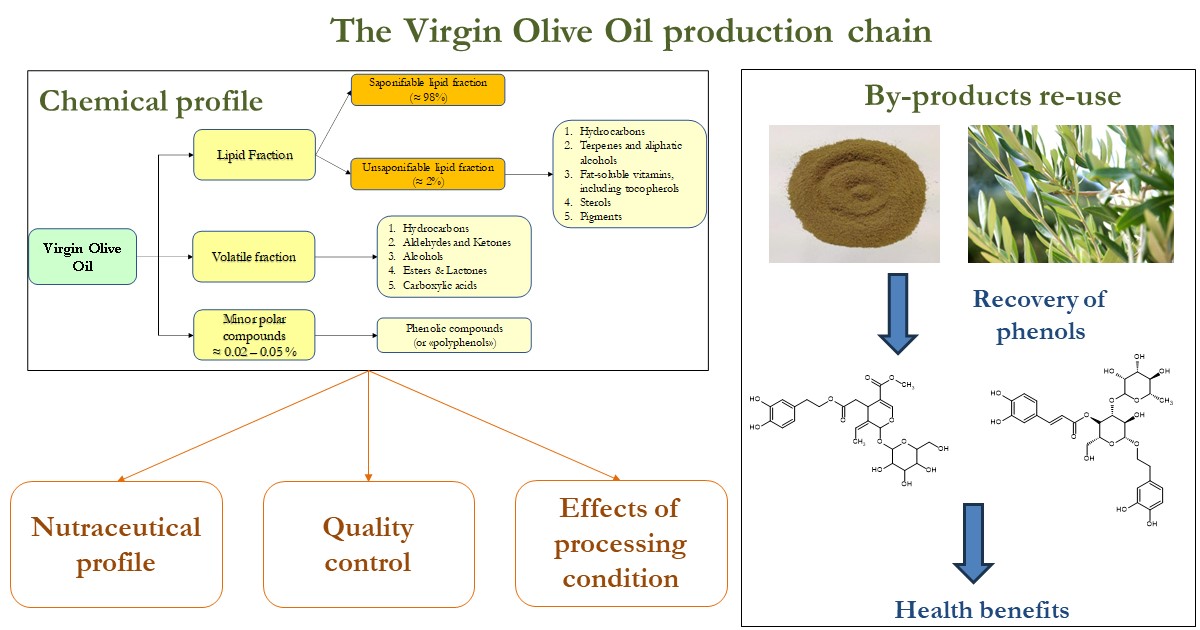- 4.6Impact Factor
- 8.6CiteScore
- 17 daysTime to First Decision
Virgin Olive Oil: Processing, Byproducts, Quality Control, and Nutraceutical Profile II
This special issue belongs to the section “Natural Products Chemistry“.
Special Issue Information
Dear Colleagues,
The interest in virgin olive oil has constantly and strongly increased over the last few decades because of the unique and delicate flavor and the nutraceutical properties of this vegetable oil. All of these properties have been associated with the presence of some classes of minor compounds, particularly phenolic and volatile compounds, in addition to the peculiar fatty acid composition, which is very rich in monounsaturated fatty acids. Searching for innovative processes capable of extracting virgin olive oil with higher and higher sensorial and nutraceutical properties is one of the current concerns of producers and researchers. At the same time, the possibility of re-using byproducts containing high levels of hydroxytyrosol, secoiridoid derivatives, and other phenolic compounds has recently been strongly investigated to render the olive oil production chain more economically and environmentally sustainable. Virgin olive oil also has the peculiarity of being the only food product to have a standardized protocol (the so-called Panel Test) for the analysis of sensory attributes that are used to classify samples according to the recognized commercial categories. Much effort is being made by researchers to develop chemical/statistical approaches that support the Panel Test in virgin olive oil classification and can be used to authenticate the geographic and botanical origin of virgin olive oils.
This Special Issue aims to cover advances in research on: i) innovations in processing olives to obtain high-quality extra virgin olive oil; ii) the possibility of re-using byproducts from olive oil extraction; iii) quality control, e.g., developing chemical/statistical methods for virgin olive classification according to the current legislation and authentication of the geographic and botanical origin; and iv) the nutraceutical potentiality of virgin olive oil, including the biological and health-promoting properties possessed by the phenolic compounds present in this vegetable oil.
Dr. Lorenzo Cecchi
Dr. Maria Bellumori
Guest Editors
Manuscript Submission Information
Manuscripts should be submitted online at www.mdpi.com by registering and logging in to this website. Once you are registered, click here to go to the submission form. Manuscripts can be submitted until the deadline. All submissions that pass pre-check are peer-reviewed. Accepted papers will be published continuously in the journal (as soon as accepted) and will be listed together on the special issue website. Research articles, review articles as well as short communications are invited. For planned papers, a title and short abstract (about 250 words) can be sent to the Editorial Office for assessment.
Submitted manuscripts should not have been published previously, nor be under consideration for publication elsewhere (except conference proceedings papers). All manuscripts are thoroughly refereed through a single-blind peer-review process. A guide for authors and other relevant information for submission of manuscripts is available on the Instructions for Authors page. Molecules is an international peer-reviewed open access semimonthly journal published by MDPI.
Please visit the Instructions for Authors page before submitting a manuscript. The Article Processing Charge (APC) for publication in this open access journal is 2700 CHF (Swiss Francs). Submitted papers should be well formatted and use good English. Authors may use MDPI's English editing service prior to publication or during author revisions.
Keywords
- virgin olive oil quality authentication
- byproduct management
- volatile compounds
- phenolic compounds
- sensory analysis
- health-promoting properties
- biological activity
- authentication of origin
- innovative extraction processes

Benefits of Publishing in a Special Issue
- Ease of navigation: Grouping papers by topic helps scholars navigate broad scope journals more efficiently.
- Greater discoverability: Special Issues support the reach and impact of scientific research. Articles in Special Issues are more discoverable and cited more frequently.
- Expansion of research network: Special Issues facilitate connections among authors, fostering scientific collaborations.
- External promotion: Articles in Special Issues are often promoted through the journal's social media, increasing their visibility.
- e-Book format: Special Issues with more than 10 articles can be published as dedicated e-books, ensuring wide and rapid dissemination.

